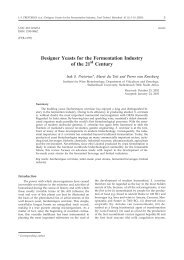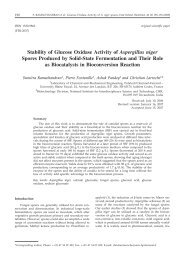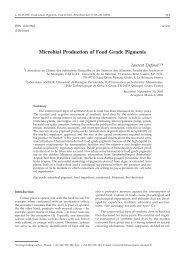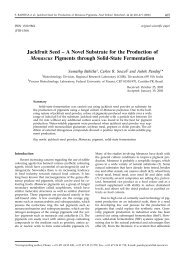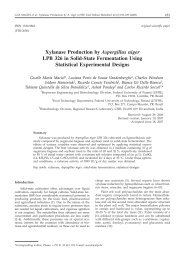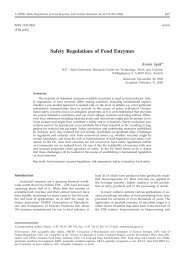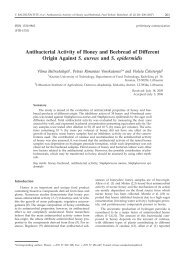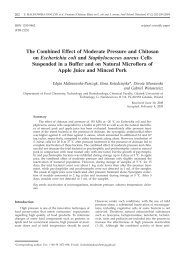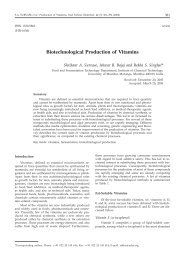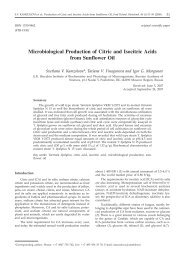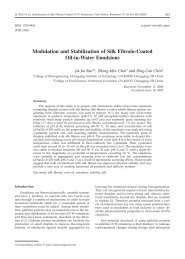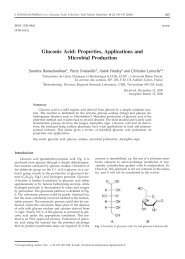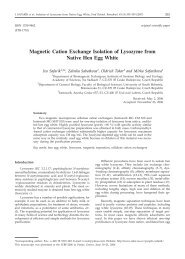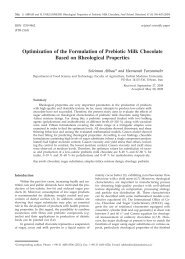A Novel Improved Design for the First-generation Glucose Biosensor
A Novel Improved Design for the First-generation Glucose Biosensor
A Novel Improved Design for the First-generation Glucose Biosensor
Create successful ePaper yourself
Turn your PDF publications into a flip-book with our unique Google optimized e-Paper software.
J. LIU and J. WANG: <strong>Improved</strong> <strong>Design</strong> <strong>for</strong> <strong>the</strong> <strong>Glucose</strong> <strong>Biosensor</strong>, Food technol. biotechnol. 39 (1) 55–58 (2001)<br />
55<br />
UDC 681.586.74:577.152.121<br />
ISSN 1330-9862<br />
review<br />
(FTB-1036)<br />
A <strong>Novel</strong> <strong>Improved</strong> <strong>Design</strong> <strong>for</strong> <strong>the</strong> <strong>First</strong>-<strong>generation</strong><br />
<strong>Glucose</strong> <strong>Biosensor</strong><br />
Jie Liu 1 * and Joseph Wang 2<br />
1 Department of Chemistry, Nantong Medical College, Nantong, JS 226001, People’s Republic of China<br />
2 Department of Chemistry and Biochemistry, New Mexico State University, Las Cruces, NM 88003, USA<br />
Received: May 17, 2000<br />
Accepted: October 26, 2000<br />
Summary<br />
The historical development of three <strong>generation</strong>s of enzyme-based amperometric glucose<br />
biosensors are compared. A novel design of <strong>the</strong> first-<strong>generation</strong> glucose biosensor<br />
based on <strong>the</strong> use of metal-dispersed carbon paste electrode is described. Such a strategy<br />
enables remarkable selectivity and improved sensitivity, without excluding or destroying<br />
<strong>the</strong> endogenous electroactive interferences, commonly associated with <strong>the</strong> first-<strong>generation</strong><br />
glucose biosensor. It offers a strong, preferential electrocatalytic action towards <strong>the</strong> enzymatically-liberated<br />
hydrogen peroxide due to <strong>the</strong> proper selection of <strong>the</strong> transducer metal-<br />
-dispersed material. On <strong>the</strong> o<strong>the</strong>r hand, a unique, non-polar pasting liquid allows efficient<br />
operation of <strong>the</strong> resulting glucose biosensor under severe depletion of oxygen or under a<br />
considerable period of <strong>the</strong>rmal stress by providing an internal oxygen supply and establishing<br />
a micro-environment of <strong>the</strong> enzyme against <strong>the</strong>rmoinactivation, respectively.<br />
Metal-dispersed carbon paste enzyme electrodes have thus become a promising new design<br />
of <strong>the</strong> first-<strong>generation</strong> biosensors, especially <strong>for</strong> blood glucose measurements and<br />
o<strong>the</strong>r bio<strong>the</strong>chnical applications due to <strong>the</strong>ir remarkable selectivity, high stability, low oxygen-dependence,<br />
and good dynamic per<strong>for</strong>mance.<br />
Key words: glucose, biosensors, enzyme electrode, metal-dispersed, carbon paste<br />
Medical applications of glucose biosensors have<br />
been expanded from clinical laboratories to patients<br />
self-control owing to <strong>the</strong> significance of blood glucose<br />
measurements and monitoring <strong>for</strong> increasing number of<br />
diabetics. Toge<strong>the</strong>r with <strong>the</strong>ir applications in food industry<br />
and o<strong>the</strong>r biotechnological areas, <strong>the</strong> development<br />
of simple and reliable glucose biosensors remains<br />
<strong>the</strong> prime focus of many researchers.<br />
Amperometric enzyme-based bioelectrodes are very<br />
suitable <strong>for</strong> self-testing and in vivo monitoring of blood<br />
glucose. The glucose amperometric sensor, developed<br />
by Updike and Hicks (1), represents <strong>the</strong> first reported<br />
use of an enzyme electrode. The so-called first-<strong>generation</strong><br />
glucose biosensor is commonly based on <strong>the</strong> entrapment<br />
of glucose oxidase (GOD) between dialysis<br />
and permselective membranes on a metal or carbon<br />
working electrode used as transducer. The liberation of<br />
hydrogen peroxide in <strong>the</strong> enzymatic reaction can be<br />
measured amperometrically at <strong>the</strong> working electrode<br />
surface:<br />
glucose + GOD(FAD + ) glucolactone + GOD(FADH 2 )<br />
FADH 2 +O 2 FAD + +H 2 O 2<br />
electrode<br />
H 2 O 2 <br />
2H + +O 2 +2e –<br />
where FAD + /FADH 2 is <strong>the</strong> cofactor of GOD, and O 2 comes<br />
from <strong>the</strong> environment (e.g. dissolved oxygen in <strong>the</strong><br />
solution).<br />
* Corresponding autor: Phone: ++86 (0)513 5532 071; Fax: ++86 (0)513 5517 359; E-mail: ntjl@bigfoot.com
56 J. LIU and J. WANG: <strong>Improved</strong> <strong>Design</strong> <strong>for</strong> <strong>the</strong> <strong>Glucose</strong> <strong>Biosensor</strong>, Food technol. biotechnol. 39 (1) 55–58 (2001)<br />
In <strong>the</strong> early stage, <strong>the</strong> enzymatic reaction was followed<br />
by monitoring <strong>the</strong> consumption of <strong>the</strong> oxygen<br />
cosubstrate, but <strong>the</strong> method was seldom used due to<br />
possible variation of oxygen in <strong>the</strong> environment.<br />
The routine use of a first-<strong>generation</strong> glucose biosensor<br />
has been hampered by two major limitations. The<br />
first limitation accrues from <strong>the</strong> fact that <strong>the</strong> amperometric<br />
monitoring of hydrogen peroxide enzymatically<br />
liberated by GOD requires high operating potential<br />
where unwanted reactions of coexisting electroactive<br />
species in biological fluids, such as ascorbic acid, uric<br />
acid and acidaminophenon interfere. The second limitation<br />
stems from <strong>the</strong> restricted solubility of oxygen in biological<br />
fluids, that limits <strong>the</strong> enzymatic reaction, and<br />
variations in <strong>the</strong> oxygen level, especially in <strong>the</strong> case of<br />
implantable glucose biosensors suitable <strong>for</strong> in vivo measurements<br />
(2–5).<br />
The improvements were achieved by replacing oxygen<br />
with a non-physiological electron acceptor, which<br />
was able to shuttle electrons from <strong>the</strong> flavin redox center<br />
of <strong>the</strong> enzyme to <strong>the</strong> surface of <strong>the</strong> working electrode.<br />
The second-<strong>generation</strong> of glucose biosensor was<br />
developed with <strong>the</strong> inclusion of such redox mediators.<br />
Using redox mediators, <strong>the</strong> measurements have become<br />
insensitive to oxygen fluctuations and can be carried out<br />
at lower, more negative potentials where <strong>the</strong> interfering<br />
reactions from physiologically coexisting electroactive<br />
species do not interfere. Organic and organometallic redox<br />
compounds, such as ferrocene and quinone derivatives,<br />
ru<strong>the</strong>nium complexes, ferricyanide, phenoxazine<br />
compounds and organic conducting salts (6–11), have<br />
been used as electron mediators, with <strong>the</strong> following<br />
working mode:<br />
glucose + GOD(FAD + ) gluconolactone + GOD(FADH 2 )<br />
FADH 2 +2Med (ox) FAD + +2Med (red) +2H +<br />
2Med (red)<br />
electrode<br />
<br />
2Med (ox) +2e –<br />
where Med (ox) and Med (red) are <strong>the</strong> oxidizing and reducing<br />
<strong>for</strong>ms of <strong>the</strong> mediator, respectively. This chemistry<br />
has led to mass-scale production of commercially available<br />
glucose biosensors, especially <strong>the</strong> development of<br />
pen-sized meters <strong>for</strong> personal glucose measurement.<br />
The single-use, disposable strips used with this device<br />
are made of polyvinyl chloride and a screen-printed carbon<br />
electrode containing a mixture of glucose oxidase<br />
and <strong>the</strong> electron mediator. A fresh drop of undiluted<br />
whole blood can thus be assayed <strong>for</strong> its glucose level in<br />
less than 60 seconds. However, <strong>the</strong> mediated enzyme<br />
electrodes may still suffer from ascorbic and uric acid<br />
interferences, and <strong>the</strong> toxicity of many artificial mediators<br />
limits <strong>the</strong>ir in vivo applications.<br />
Ano<strong>the</strong>r, even more elegant, possibility is to achieve<br />
direct, unmediated electrical communication between<br />
glucose oxidase an <strong>the</strong> electrode surface. The modification<br />
of glucose oxidase with an appropriate electron relay<br />
has been successfully employed <strong>for</strong> this advanced<br />
design. It has been possible to »wire« <strong>the</strong> enzyme to <strong>the</strong><br />
electrode with a long chain polymer having a dense array<br />
of electron relays, which is flexible enough to fold<br />
along <strong>the</strong> enzyme structure. Ultimately, this third-<strong>generation</strong><br />
of glucose biosensor would lead to implantable,<br />
needle-type devices <strong>for</strong> continuous in vivo monitoring of<br />
blood glucose (12,13). Such devices would offer an improved<br />
control of diabetes, in connection with an internal<br />
insulin release system.<br />
It must be considered that glucose biosensors <strong>for</strong><br />
medical applications have been developed to a promising<br />
stage following <strong>the</strong> more and more sophisticated<br />
technical design. In this article, a novel and simple design,<br />
based on <strong>the</strong> first-<strong>generation</strong> glucose biosensor is<br />
described by focusing on transducer. This design is<br />
developed in <strong>the</strong> laboratory of Dr. Joseph Wang at<br />
NMSU (Las Cruces, NM, USA) and is based on a metal-<br />
-dispersed catalytic materials.<br />
What is <strong>the</strong> basis of an absolutely selective transduction<br />
process to <strong>the</strong> enzymatically-librated hydrogen<br />
peroxide in <strong>the</strong> above-mentioned biosensor? The principles<br />
of traditional »first <strong>generation</strong>« glucose biosensors<br />
depends on <strong>the</strong> immobilization of glucose oxidase onto<br />
<strong>the</strong> carbon or metal transducers and detection of <strong>the</strong> anodic<br />
current associated with <strong>the</strong> hydrogen peroxide enzymatically<br />
generated by glucose and dioxygen substrates.<br />
Accordingly, those easily oxidizable endogenous<br />
constituents undergo oxidation at a fairly positive potential<br />
(>+0.7 V vs. AgAgCl) required <strong>for</strong> detection of<br />
<strong>the</strong> hydrogen peroxide. The error caused by <strong>the</strong> signal<br />
overlapping from both <strong>the</strong> analyte and interfering materials<br />
is significant, although <strong>the</strong> latter exists in physiological<br />
fluids at much lower levels compared with <strong>the</strong><br />
<strong>for</strong>mer. A new design, using metallized carbon electrodes<br />
instead of <strong>the</strong> traditional transducers, offers preferential<br />
electrocatalytic detection of hydrogen peroxide,<br />
in particular yielding <strong>the</strong> cathodic current response under<br />
<strong>the</strong> lower potentials around 0.0 V, where <strong>the</strong> endogenous<br />
constituents are almost electroinactive, giving<br />
very small current response.<br />
A metal-dispersed carbon paste enzyme electrode<br />
might be <strong>the</strong> most important member of <strong>the</strong>se novel,<br />
first-<strong>generation</strong> biosensors. Some examples of ru<strong>the</strong>nium-,<br />
rhodium-, iridium-dispersed carbon paste/GOD<br />
biosensors have been reported to offer an amperometric<br />
biosensing of glucose, achieving marked selectivity, attractive<br />
dynamic properties and reduced sensor configuration<br />
complexity (14–16).<br />
Three-dimensionally dispersed metal particles in<br />
graphite show <strong>the</strong> unique electrocatalytic action to hydrogen<br />
peroxide in comparison with pure metal or carbon<br />
surface, greatly lowering <strong>the</strong> over-potential ei<strong>the</strong>r in<br />
oxidation or reduction direction. Electroreduction of<br />
hydrogen peroxide on such metal dispersed carbon<br />
paste electrodes is responsible <strong>for</strong> <strong>the</strong>ir absolutely selective<br />
amperometric biosensing of glucose, because <strong>the</strong><br />
unwanted electrooxidation of those endogenous interfering<br />
constituents do not occur at so low potential region<br />
(approximately 0.0 V) required <strong>for</strong> <strong>the</strong> electroreduction<br />
of enzymatically generated hydrogen peroxide.<br />
In addition, <strong>the</strong> stable electrocatalytic activity due to <strong>the</strong><br />
strong adherence of metal centers to <strong>the</strong> graphite and<br />
<strong>the</strong> considerably lower background signals (similar to<br />
that of an ordinary carbon paste) of <strong>the</strong> resulting electrodes,<br />
make <strong>the</strong>m more and more attactive <strong>for</strong> glucose<br />
biosensors. It is worth mentioning that <strong>the</strong> metal dispersed<br />
graphite might be regarded as <strong>the</strong> transition metals-based<br />
»supporting catalysis«. The study of <strong>the</strong> mech-
J. LIU and J. WANG: <strong>Improved</strong> <strong>Design</strong> <strong>for</strong> <strong>the</strong> <strong>Glucose</strong> <strong>Biosensor</strong>, Food technol. biotechnol. 39 (1) 55–58 (2001)<br />
57<br />
anism of <strong>the</strong>ir electrocatalytic activity is beneficial not<br />
only <strong>for</strong> <strong>the</strong> elucidation of <strong>the</strong> electrode kinetics, but<br />
also <strong>for</strong> <strong>the</strong> development of glucose biosensors. The bimetallic<br />
(ru<strong>the</strong>nium-platinum) alloy dispersed carbon<br />
paste/GOD electrodes have been constructed and compared<br />
with <strong>the</strong> single metal dispersed ones in relation to<br />
<strong>the</strong>ir selectivity, sensitivity and o<strong>the</strong>r dynamic properties<br />
(17). Figs. 1 and 2 show that <strong>the</strong> alloy-dispersed carbon/GOD<br />
electrode produced a greatly enhanced sensitivity,<br />
without compromising <strong>the</strong> remarkable selectivity<br />
inherent to metallized carbon biosensors. The use of carbon-supported<br />
alloy particles resulted in greatly improved<br />
properties of <strong>the</strong> biosensor in comparison to<br />
biocomposite with dispersion of pure metals. This<br />
would be contributive to <strong>the</strong> understanding of <strong>the</strong><br />
electrocatalysis of metallized carbon.<br />
The metal-dispersed carbon paste enzyme electrodes,<br />
like ordinary carbon paste electrodes, showed<br />
<strong>the</strong> advantages of low background noise, renewed and<br />
modified surfaces, miniaturization and easily prepared<br />
(sufficiently <strong>for</strong> <strong>the</strong> mass-producible, disposable sensors,<br />
e.g. screen-printed strips), that initiates fur<strong>the</strong>r interests<br />
in <strong>the</strong>m.<br />
Carbon paste used <strong>for</strong> <strong>the</strong> preparation of glucose<br />
biosensors consisted of a mixture of graphite powder<br />
and an organic pasting liquid, commonly mineral oil.<br />
The pasting liquid not only serves <strong>for</strong> filling <strong>the</strong> crevices<br />
between <strong>the</strong> graphite particles but also prepares an electrode<br />
that is fundamentally different from those pure<br />
metal electrodes, such as Pt and Au electrodes, commonly<br />
used <strong>for</strong> amperometric transduction. It is well<br />
known that <strong>the</strong> solubility of oxygen is many times<br />
greater in some organic solvents than in water. In particular,<br />
fluorochemicals have been used as oxygen transporters<br />
and blood substitutes in humans and animals in<br />
relation to <strong>the</strong> very high oxygen solubility in such solvents<br />
(resembling to that in haemoglobin). Taking advantage<br />
of this remarkable oxygen solubility, an oxygen-insensitive<br />
first-<strong>generation</strong> enzyme electrode based<br />
on fluorochemical carbon paste has been constructed<br />
(18), achieving a satisfied oxygen independence which<br />
rivals that reported <strong>for</strong> mediated or wired enzyme electrodes.<br />
As mentioned above, carbon paste enzyme electrodes<br />
with <strong>the</strong> improvements both in graphite and in<br />
pasting liquid diminish <strong>the</strong> major limitations of <strong>the</strong><br />
first-<strong>generation</strong> glucose biosensor. In addition, a fur<strong>the</strong>r<br />
investigation showed that a variety of oxidases (including<br />
GOD) entrapped within non-polar carbon paste acquired<br />
a remarkable stability, especially a resistance to<br />
<strong>the</strong>rmoinactivation (19). It took an extended period of 4<br />
months to examine <strong>the</strong> long-term stability of a GOD-<br />
-containing carbon paste biosensor at <strong>the</strong> elevated temperature<br />
of 60 °C (as shown in Fig. 3). These remarkable<br />
Fig. 1. Amperometric reduction response at <strong>the</strong> Pt-Ru- (a), Ru-<br />
(b), Pt- (c) dispersed carbon and plain carbon (d) enzyme<br />
electrodes upon increasing concentration of glucose in 2<br />
mmol/L steps; working potential = –0.05; electrolyte = phosphate<br />
buffer (0.05 mol/L, pH=7.4) stirred at 300 rpm. The resulting<br />
calibration curves are also shown (inset)<br />
Fig. 2. Flow-injection (A) and batch (B) amperometric signals<br />
at <strong>the</strong> Pt-Ru-dispersed carbon paste glucose oxidase electrode<br />
<strong>for</strong> addition of 8 mmol/L glucose (a); 0.4 mmol/L ascorbic acid<br />
(b); 0.4 mmol/L uric acid (c); and 0.4 mmol/L acetaminophenon<br />
(d), or 5 mmol/L glucose (a’); 0.1 mmol/L ascorbic acid<br />
(b’); 0.1 mmol/L uric acid (c’), and 0.1 mmol/L acetaminophenon<br />
(d’). Conditions are <strong>the</strong> same as in Fig. 1, exept that a flow<br />
rate of 1.5 mL/mim was used in (B)
58 J. LIU and J. WANG: <strong>Improved</strong> <strong>Design</strong> <strong>for</strong> <strong>the</strong> <strong>Glucose</strong> <strong>Biosensor</strong>, Food technol. biotechnol. 39 (1) 55–58 (2001)<br />
measurements and o<strong>the</strong>r biotechnological applications<br />
due to its almost absolute selectivity, high stability, low<br />
oxygen-dependence and dynamic per<strong>for</strong>mance.<br />
References<br />
Fig. 3. Long-term time dependence of <strong>the</strong> activity of GOD entrapped<br />
in Rh-dispersed carbon paste and stored at 60 °C <strong>for</strong><br />
4 months; insets show <strong>the</strong> actual response of <strong>the</strong> Rh/GOD carbon<br />
paste electrode at <strong>the</strong> start (curve A), middle (58 th day,<br />
curve B), and end (117 th day, curve C) of this experiment. The<br />
same electrode surface was used throughout. The activity was<br />
assayed at <strong>the</strong> times indicated by amperometric response to 2<br />
mM glucose at <strong>the</strong> electrode. Working potential = –0.05 V; electrolyte<br />
= 0.05 M phosphate buffer (pH = 7.4) stirred at 300 rpm<br />
<strong>the</strong>rmostabilities might be related to <strong>the</strong> fact that several<br />
enzymes are more stable in organic media than in water.<br />
Such enhanced resistance towards <strong>the</strong>rmal denaturation<br />
stems from <strong>the</strong> high con<strong>for</strong>mation rigidity of dehydrated<br />
enzymes and from <strong>the</strong> lack of free water<br />
molecules, usually required in all enzyme-inactivation<br />
processes.<br />
In conclusion, <strong>the</strong> carbon paste enzyme electrode<br />
prepared with a metal- or metal alloy-dispersed graphite<br />
and a non-polar pasting liquid which has high oxygen<br />
solubility has become a promising design of <strong>the</strong><br />
first-<strong>generation</strong> biosensor, especially <strong>for</strong> blood glucose<br />
1. S. J. Updie, G. P. Hicks, Nature, 214 (1967) 956; Science, 158<br />
(167) 270.<br />
2. R. M. Ianniello, A. M. Yacynych, Anal. Chem. 53 (1981)<br />
2090.<br />
3. A. Tuner, I. Karube, G. Wilson: <strong>Biosensor</strong>: Fundamentals and<br />
Applications, Ox<strong>for</strong>d, Science Publ. (1987).<br />
4. A. E. Cass: <strong>Biosensor</strong>s: A Practical Approach, Ox<strong>for</strong>d, Pergamon<br />
(1990).<br />
5. G. Rechnitz, Electroanalysis, 3 (1991) 73.<br />
6. A. E. Cass, G. Davis, M. J. Green, H. A. Hill, J. Electroanal.<br />
Chem. 190 (1985) 117.<br />
7. M. J. Green, P. Hilditch, Anal. Proc. 28 (1991) 374.<br />
8. W. J. Albery, P. N. Bartlett, D. H. Craston, J. Electroanal.<br />
Chem. 194 (1985) 223.<br />
9. J. Hu, A. Turner, Anal. Lett. 24 (1991) 15.<br />
10. H. Gunashingham, C. Tan, Analyst, 115 (1990) 35.<br />
11. J. Kulys, H. Hansen, T. Buch-Rasmussen, J. Wang, M.<br />
Ozsoz, Anal. Chim. Acta, 228 (1994) 193.<br />
12. Y. Degani, A. Heller, J. Phys. Chem. 91 (1987) 1285; J. Am.<br />
Chem. Soc. 111 (1989) 2357.<br />
13. I. Katakis, A. Heller, In: Frontiers in <strong>Biosensor</strong>ics I, F. W.<br />
Scheller, F. Schubert, J. Fredowitz, (Eds.), Birkhauser<br />
Verlag, Basel (1997).<br />
14. J. Wang, L. Fang, D. Lopez, H. Tonbias, Anal. Lett. 26<br />
(1993) 9.<br />
15. J. Wang, J. Liu, L. Chen, F. Lu, Anal. Chem. 66 (1994) 3600.<br />
16. J. Wang, G. Rivas, M. Chicharo, Electroanalysis, 8 (1996)<br />
434.<br />
17. J. Liu, F. Lu, J. Wang, Electrochem. Commun. 1 (1999) 341.<br />
18. J. Wang, F. Lu, J. Am. Chem. Soc. 20 (1998) 8281.<br />
19. J. Wang. J. Liu, G. Cepra, Anal. Chem. 69 (1997) 3124.<br />
Nova konstrukcija prve generacije biosenzora za glukozu<br />
Sa`etak<br />
Povijesni razvoj na enzimu zasnovanim amperometrijskim biosenzorima za glukozu<br />
prikazan je prema njihovoj razli~itoj izvedbi, a razra|en je u tzv. tri generacije. Uporaba<br />
paste koja se sastoji od metala dispergiranog u ugljenu daje pobolj{anu prvu generaciju<br />
biosenzora za glukozu. Takav na~in da se postigne bitna selektivnost ne sastoji se u isklju-<br />
~ivanju ili uni{tenju endogenih elektroaktivnih interferencija, kao kod svih biosenzora za<br />
glukozu prve generacije, ve} u sna`nom, izrazitom elektrokataliti~kom djelovanju prema u<br />
enzimskoj reakciji oslobo|enom vodikovom peroksidu usredoto~iv{i se na materijal provodnika<br />
(transducer). S druge strane, nepolarna teku}a pasta omogu}ava djelotvoran rad<br />
biosenzora za glukozu i pod zna~ajnim nedostatkom kisika osigurava internu dobavu<br />
kisika, a pri znatno dugom termalnom stresu uspostavlja mikrookoli{ kojim za{ti}uje<br />
enzim od toplinske inaktivacije. Enzimske elektrode s metalom dispergiranim u ugljenoj<br />
pasti postale su perspektivni model za biosenzore prve generacije, osobito za odre|ivanje<br />
glukoze u krvi i za druge biokemijske primjene zbog njihove apsolutne selektivnosti,<br />
velike stabilnosti, male ovisnosti o kisiku i dobre dinami~ke provedbe.



